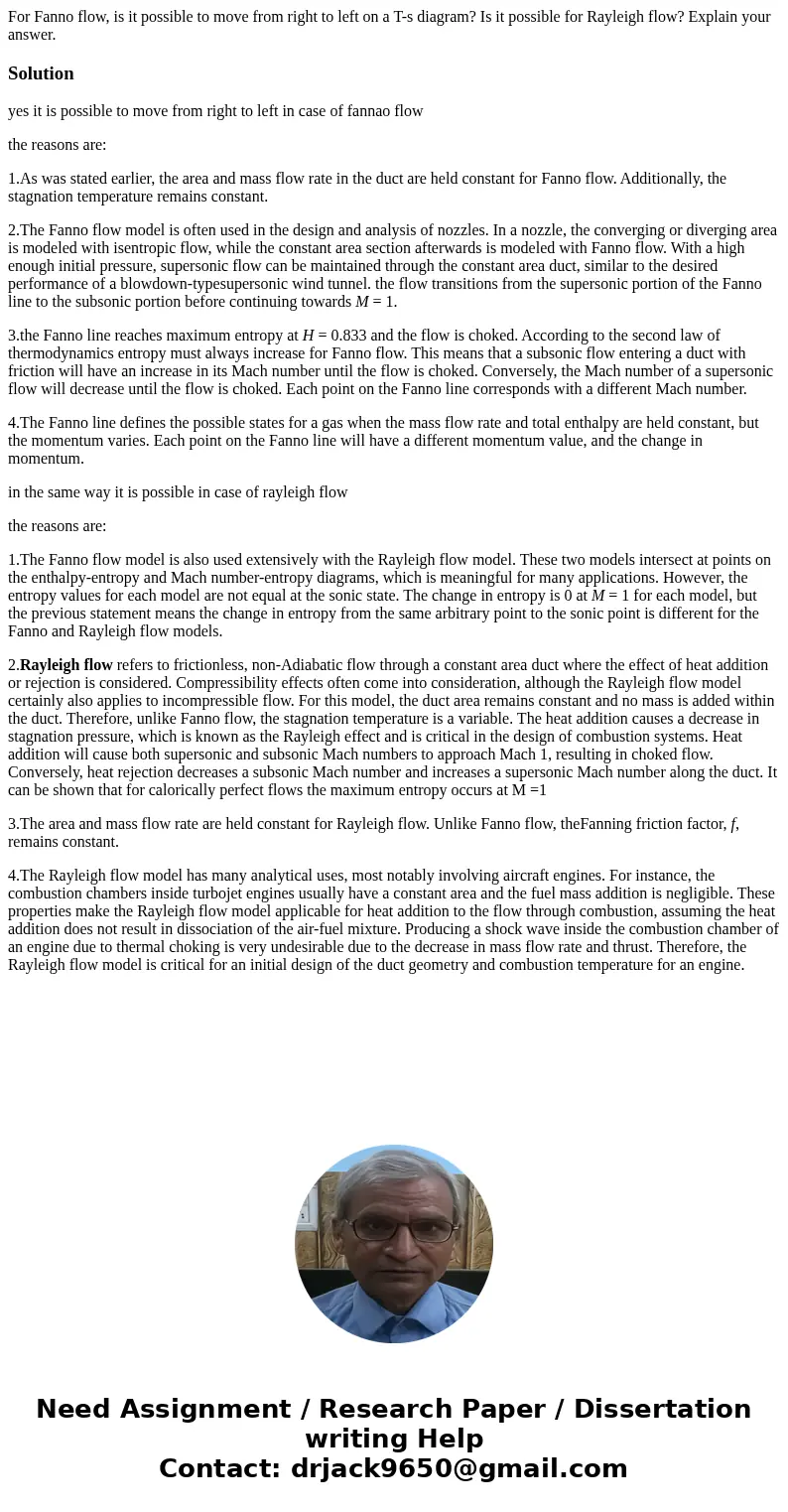For Fanno flow is it possible to move from right to left on
For Fanno flow, is it possible to move from right to left on a T-s diagram? Is it possible for Rayleigh flow? Explain your answer.
Solution
yes it is possible to move from right to left in case of fannao flow
the reasons are:
1.As was stated earlier, the area and mass flow rate in the duct are held constant for Fanno flow. Additionally, the stagnation temperature remains constant.
2.The Fanno flow model is often used in the design and analysis of nozzles. In a nozzle, the converging or diverging area is modeled with isentropic flow, while the constant area section afterwards is modeled with Fanno flow. With a high enough initial pressure, supersonic flow can be maintained through the constant area duct, similar to the desired performance of a blowdown-typesupersonic wind tunnel. the flow transitions from the supersonic portion of the Fanno line to the subsonic portion before continuing towards M = 1.
3.the Fanno line reaches maximum entropy at H = 0.833 and the flow is choked. According to the second law of thermodynamics entropy must always increase for Fanno flow. This means that a subsonic flow entering a duct with friction will have an increase in its Mach number until the flow is choked. Conversely, the Mach number of a supersonic flow will decrease until the flow is choked. Each point on the Fanno line corresponds with a different Mach number.
4.The Fanno line defines the possible states for a gas when the mass flow rate and total enthalpy are held constant, but the momentum varies. Each point on the Fanno line will have a different momentum value, and the change in momentum.
in the same way it is possible in case of rayleigh flow
the reasons are:
1.The Fanno flow model is also used extensively with the Rayleigh flow model. These two models intersect at points on the enthalpy-entropy and Mach number-entropy diagrams, which is meaningful for many applications. However, the entropy values for each model are not equal at the sonic state. The change in entropy is 0 at M = 1 for each model, but the previous statement means the change in entropy from the same arbitrary point to the sonic point is different for the Fanno and Rayleigh flow models.
2.Rayleigh flow refers to frictionless, non-Adiabatic flow through a constant area duct where the effect of heat addition or rejection is considered. Compressibility effects often come into consideration, although the Rayleigh flow model certainly also applies to incompressible flow. For this model, the duct area remains constant and no mass is added within the duct. Therefore, unlike Fanno flow, the stagnation temperature is a variable. The heat addition causes a decrease in stagnation pressure, which is known as the Rayleigh effect and is critical in the design of combustion systems. Heat addition will cause both supersonic and subsonic Mach numbers to approach Mach 1, resulting in choked flow. Conversely, heat rejection decreases a subsonic Mach number and increases a supersonic Mach number along the duct. It can be shown that for calorically perfect flows the maximum entropy occurs at M =1
3.The area and mass flow rate are held constant for Rayleigh flow. Unlike Fanno flow, theFanning friction factor, f, remains constant.
4.The Rayleigh flow model has many analytical uses, most notably involving aircraft engines. For instance, the combustion chambers inside turbojet engines usually have a constant area and the fuel mass addition is negligible. These properties make the Rayleigh flow model applicable for heat addition to the flow through combustion, assuming the heat addition does not result in dissociation of the air-fuel mixture. Producing a shock wave inside the combustion chamber of an engine due to thermal choking is very undesirable due to the decrease in mass flow rate and thrust. Therefore, the Rayleigh flow model is critical for an initial design of the duct geometry and combustion temperature for an engine.

 Homework Sourse
Homework Sourse